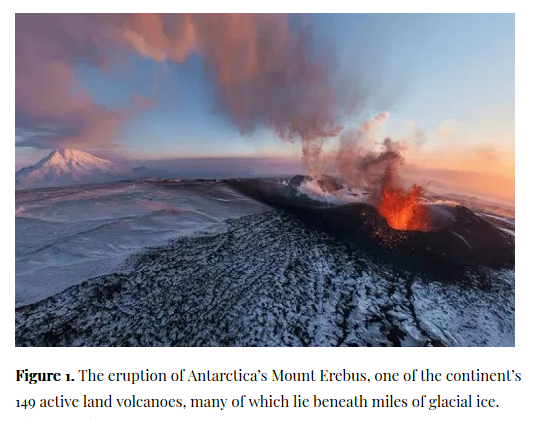In August 2018 (yes, I know that was last year, but I missed this), The Climate Change Dispatch posted an article with the following headline, “Multiple NASA Studies Confirm Bedrock Heat Flow Behind Melting Polar Ice, Not Global Warming.” Wow. Who knew?
The article includes the following photo:
In what amounts to dissension from National Aeronautics and Space Administration (NASA) climate change policy, a series of just-released studies by working-level scientists prove that geological and not atmospheric forces are responsible for melting of Earth’s polar ice sheets.
NASA Antarctica Study October 30, 2015
This research study authored by NASA Glaciologist Jay Zwally concluded that Antarctica is gaining, not losing, ice mass and thereby challenging the conclusions of many previous studies, most importantly the Intergovernmental Panel on Climate Change’s (IPCC) 2013 report (see the quote from the study below).
“A new NASA study says that an increase in Antarctic snow accumulation that began 10,000 years ago is currently adding enough ice to the continent to outweigh the increased losses from its thinning glaciers.
“The research challenges the conclusions of other studies, including the Intergovernmental Panel on Climate Change’s (IPCC) 2013 report, which says that Antarctica is overall losing land ice.
The article continues:
The conclusions of this NASA study were immediately challenged by numerous climate activist groups and biased media outlets (see here). These challenges have since been proven incorrect for several reasons.
Statements by NASA Glaciologist Jay Zwally concerning his soon-to-be-published Antarctic follow-up study reconfirm that Antarctica is gaining, not losing ice.
The results of this follow-up study are bolstered by two other NASA research studies.
The first, dated January 1, 2018, shows that East Antarctica has for many years been accumulating huge amounts of snow that compact into ice and increasing overall ice mass (see here).
The second NASA study released on July 19, 2018, showed that the atmosphere above the Antarctic Continent has been continuously cooling and not warming for many years (see here).
Obviously, it’s impossible to melt Antarctica’s glaciers via atmospheric warming when the atmosphere is not warming.
Lastly, a NASA study dated Feb. 20, 2018, concludes that outflow of East Antarctic glaciers into the ocean is stable and not increasing (see here). This is proof that East Antarctica’s ice mass is not being diminished by glacial outflow into adjacent oceans.
Bottom line, research by NASA scientists clearly shows that the well-documented ice loss in West Antarctica is more than accommodated by ice gains in East Antarctica. Contrary to hundreds of pro-melting articles, Antarctica’s ice mass is increasing!
When you read an article about man-made climate change, consider the following:
In March 2016, I posted an article with the following:
…Then listen to the words of former United Nations climate official Ottmar Edenhofer:
“One has to free oneself from the illusion that international climate policy is environmental policy. This has almost nothing to do with the environmental policy anymore, with problems such as deforestation or the ozone hole,” said Edenhofer, who co-chaired the U.N.’s Intergovernmental Panel on Climate Change working group on Mitigation of Climate Change from 2008 to 2015.
So what is the goal of environmental policy?
“We redistribute de facto the world’s wealth by climate policy,” said Edenhofer.
It’s really not about the climate.

